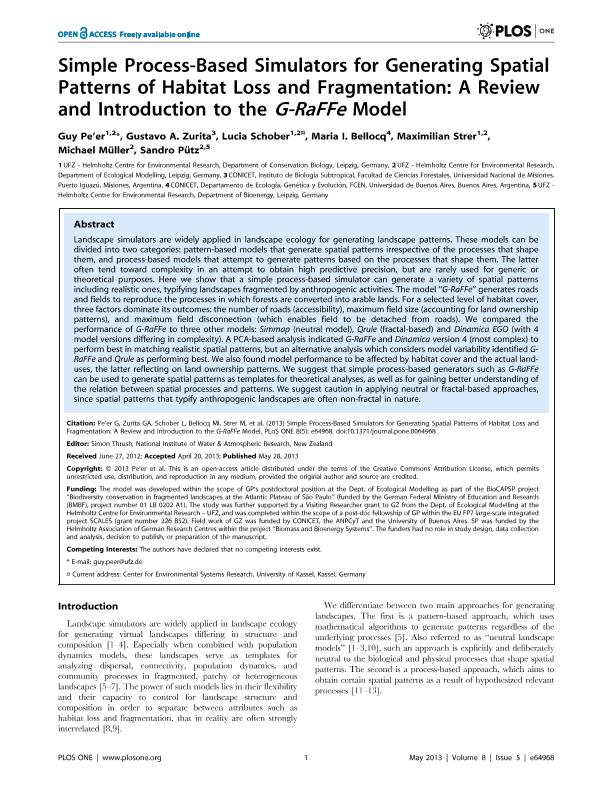Artículo
Simple process-based simulators for generating spatial patterns of habitat loss and fragmentation: a review and introduction to the G-RaFFe model
Pe’er, Guy; Zurita, Gustavo Andres ; Schober, Lucía; Bellocq, Maria Isabel
; Schober, Lucía; Bellocq, Maria Isabel ; Strer, Maximilian; Muller, Michael; Putz, Sandro
; Strer, Maximilian; Muller, Michael; Putz, Sandro
 ; Schober, Lucía; Bellocq, Maria Isabel
; Schober, Lucía; Bellocq, Maria Isabel ; Strer, Maximilian; Muller, Michael; Putz, Sandro
; Strer, Maximilian; Muller, Michael; Putz, Sandro
Fecha de publicación:
05/2013
Editorial:
Public Library Science
Revista:
Plos One
e-ISSN:
1932-6203
Idioma:
Inglés
Tipo de recurso:
Artículo publicado
Clasificación temática:
Resumen
Landscape simulators are widely applied in landscape ecology for generating landscape patterns. These models can be divided into two categories: pattern-based models that generate spatial patterns irrespective of the processes that shape them, and process-based models that attempt to generate patterns based on the processes that shape them. The latter often tend toward complexity in an attempt to obtain high predictive precision, but are rarely used for generic or theoretical purposes. Here we show that a simple process-based simulator can generate a variety of spatial patterns including realistic ones, typifying landscapes fragmented by anthropogenic activities. The model ‘‘G-RaFFe’’ generates roads and fields to reproduce the processes in which forests are converted into arable lands. For a selected level of habitat cover, three factors dominate its outcomes: the number of roads (accessibility), maximum field size (accounting for land ownership patterns), and maximum field disconnection (which enables field to be detached from roads). We compared the performance of G-RaFFe to three other models: Simmap (neutral model), Qrule (fractal-based) and Dinamica EGO (with 4 model versions differing in complexity). A PCA-based analysis indicated G-RaFFe and Dinamica version 4 (most complex) to perform best in matching realistic spatial patterns, but an alternative analysis which considers model variability identified GRaFFe and Qrule as performing best. We also found model performance to be affected by habitat cover and the actual landuses, the latter reflecting on land ownership patterns. We suggest that simple process-based generators such as G-RaFFe can be used to generate spatial patterns as templates for theoretical analyses, as well as for gaining better understanding of the relation between spatial processes and patterns. We suggest caution in applying neutral or fractal-based approaches, since spatial patterns that typify anthropogenic landscapes are often non-fractal in nature.
Palabras clave:
Atlantic Forest
,
Simulator
,
Model
Archivos asociados
Licencia
Identificadores
Colecciones
Articulos(IBS)
Articulos de INSTITUTO DE BIOLOGIA SUBTROPICAL
Articulos de INSTITUTO DE BIOLOGIA SUBTROPICAL
Articulos(IEGEBA)
Articulos de INSTITUTO DE ECOLOGIA, GENETICA Y EVOLUCION DE BS. AS
Articulos de INSTITUTO DE ECOLOGIA, GENETICA Y EVOLUCION DE BS. AS
Citación
Pe’er, Guy; Zurita, Gustavo Andres; Schober, Lucía; Bellocq, Maria Isabel; Strer, Maximilian; et al.; Simple process-based simulators for generating spatial patterns of habitat loss and fragmentation: a review and introduction to the G-RaFFe model; Public Library Science; Plos One; 8; 5; 5-2013; 1-14; e64968
Compartir
Altmétricas



